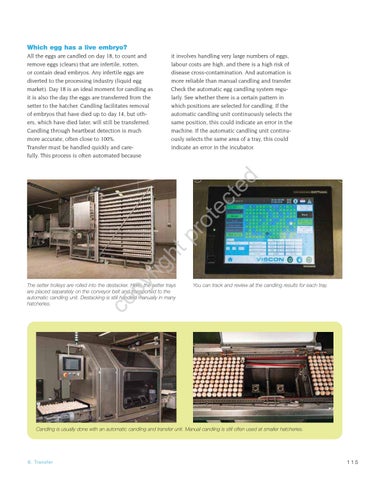Which egg has a live embryo? it involves handling very large numbers of eggs, labour costs are high, and there is a high risk of disease cross-contamination. And automation is more reliable than manual candling and transfer. Check the automatic egg candling system regularly. See whether there is a certain pattern in which positions are selected for candling. If the automatic candling unit continuously selects the same position, this could indicate an error in the machine. If the automatic candling unit continuously selects the same area of a tray, this could indicate an error in the incubator.
py
rig
ht
pr ot
ec
te
d
All the eggs are candled on day 18, to count and remove eggs (clears) that are infertile, rotten, or contain dead embryos. Any infertile eggs are diverted to the processing industry (liquid egg market). Day 18 is an ideal moment for candling as it is also the day the eggs are transferred from the setter to the hatcher. Candling facilitates removal of embryos that have died up to day 14, but others, which have died later, will still be transferred. Candling through heartbeat detection is much more accurate, often close to 100%. Transfer must be handled quickly and carefully. This process is often automated because
You can track and review all the candling results for each tray.
co
The setter trolleys are rolled into the destacker. Here, the setter trays are placed separately on the conveyor belt and transported to the automatic candling unit. Destacking is still handled manually in many hatcheries.
Candling is usually done with an automatic candling and transfer unit. Manual candling is still often used at smaller hatcheries.
8. Tr a n sf e r
115








































































































